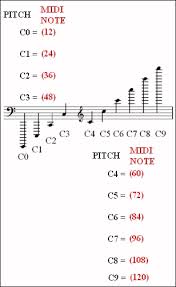MIDI Note Numbers
for Different Octaves
Octave notation is given here in the International
Organization for Standardization ISO
system, ISO was formed to include/replace the American
National Standards Institute (ANSI) and Deutsches
Institut für Normung (DIN),
the German standards institute.
In this system, middle C (MIDI note number 60) is C4. A MIDI
note number of 69 is used for A440 tuning, that is the A
note above middle C.
|
Octave |
Note Numbers |
|
C |
C# |
D |
D# |
E |
F |
F# |
G |
G# |
A |
A# |
B |
|
-1 |
0 |
1 |
2 |
3 |
4 |
5 |
6 |
7 |
8 |
9 |
10 |
11 |
|
0 |
12 |
13 |
14 |
15 |
16 |
17 |
18 |
19 |
20 |
21 |
22 |
23 |
|
1 |
24 |
25 |
26 |
27 |
28 |
29 |
30 |
31 |
32 |
33 |
34 |
35 |
|
2 |
36 |
37 |
38 |
39 |
40 |
41 |
42 |
43 |
44 |
45 |
46 |
47 |
|
3 |
48 |
49 |
50 |
51 |
52 |
53 |
54 |
55 |
56 |
57 |
58 |
59 |
|
4 |
60 |
61 |
62 |
63 |
64 |
65 |
66 |
67 |
68 |
69 |
70 |
71 |
|
5 |
72 |
73 |
74 |
75 |
76 |
77 |
78 |
79 |
80 |
81 |
82 |
83 |
|
6 |
84 |
85 |
86 |
87 |
88 |
89 |
90 |
91 |
92 |
93 |
94 |
95 |
|
7 |
96 |
97 |
98 |
99 |
100 |
101 |
102 |
103 |
104 |
105 |
106 |
107 |
|
8 |
108 |
109 |
110 |
111 |
112 |
113 |
114 |
115 |
116 |
117 |
118 |
119 |
|
9 |
120 |
121 |
122 |
123 |
124 |
125 |
126 |
127 |

MIDI Note Numbers
The MIDI specification only defines note number 60 as
"Middle C", and all other notes are relative. The absolute
octave number designations shown here are based on Middle C
= C4.
There is a discrepancy that occurs between various models of
MIDI devices and software programs, and that concerns the
octave numbers for note names. If your MIDI software/device
considers octave 0 as being the lowest octave of the MIDI
note range, then middle C's note name is C5. The lowest note
name is then C0 (note number 0), and the highest possible
note name is G10 (note number 127).
Some software/devices instead consider the third octave of
the MIDI note range (2 octaves below middle C) as octave 0.
In that case, the first 2 octaves are referred to as -2 and
-1. So, middle C's note name is C3, the lowest note name is
C-2, and the highest note name is G8.
A MIDI controller can have up to 128 distinct pitches/notes.
But whereas musicians name the keys using the alphabetical
names, with sharps and flats, and also octave numbers, this
is more difficult for MIDI devices to process, so they
instead assign a unique number to each key.
The numbers used are 0 to 127. The lowest note upon a MIDI
controller is a C and this is assigned note number 0. The C#
above it would have a note number of 1. The D note above
that would have a note number of 2. So "Middle C" is note
number 60. A MIDI
note number of 69 is used for A440 tuning, that is the A
note above middle C.
Most keyboard controllers have a "MIDI transpose" function
so that, even if you don't have the full 128 keys, you can
alter the note range that your keyboard covers. For example,
instead of that lowest A key being assigned to note number
21, you could transpose it down an octave so that it is
assigned a note number of 9.
MIDI Note Names
Many instruments can play distinct pitches. For example, an
acoustic piano has 88 keys, or 88 distinct pitches/notes.
Instruments with keyboards were among the earliest, most
versatile musical instruments at around the time when
musicians were devising a way to notate music. So, it's
traditional to name musical pitches based upon the piano
keyboard. They are visually grouped into octaves where one
octave contains 12 keys.
Musicians name the musical pitches played upon the white
keys by using the alphabetical names A to G. For example,
"middle C" is the white key closest to the center of the
keyboard. Musicians append sharps or flats to the
alphabetical names to identify the black keys. For example,
the black key above middle C is a C#. Also, musicians use
the octave number to further identify a particular key.

MIDI is a
trademark of MIDI Manufacturers Association Incorporated.
About MIDI -
Making Music with MIDI
- MIDI Controllers -
MIDI Products -
MIDI Glossary -
MIDI Polyphonic
Expression (MPE)

